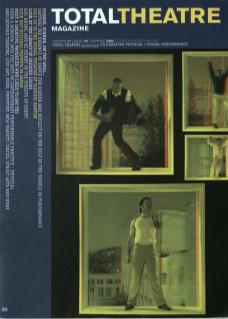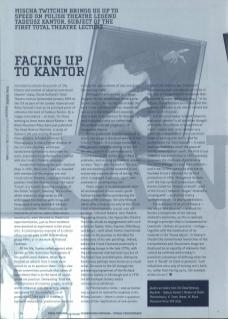Mischa Twitchin brings us up to speed on Polish theatre legend Tadeusz Kantor, subject of the first Total Theatre Lecture.
Intended to initiate discussion of ‘the history and context of physical and visual theatre’ today, David Gothard’s Total Theatre Lecture (presented January 2005 at the ICA as part of the London International Mime Festival) took as its principal point of reference the work of Tadeusz Kantor. By a happy coincidence – at least, for those wanting to know more about Kantor – the Black Mountain Press have just published The Dead Memory Machine, a study of Kantor’s life and work by Krzysztof Plesniarowicz. A friend of Kantor’s, Plesniarowicz is also a former director of the Cricoteka Archive, which was established by Kantor to document his work, especially his performances created with the Cricot 2 Theatre company.
Established following the post-Stalinist thaw in 1955, the Cricot 2 was co-founded with members of the original pre-war Cricot artists’ theatre, composed mainly of painters from the Krakow Group. The name ‘Cricot’ is a French-sounding anagram of Polish ‘to cyrk’, meaning ‘it’s a circus’, which relates its inspiration to the widespread fascination with circus and fairground in early twentieth-century theatre practice. These companies, as ensembles of artists rather than actors necessarily, were devoted to theatrical experimentation, just as their members were devoted to experimention in the visual arts. A contemporary example of a similar ethos can be seen in the St Petersburg group Akhe, or in the work of Richard Foreman.
All his life, Kantor railed against what he saw as ‘the restrictive conventions of the professional theatre, which have become so natural that it never even occurs to us to question them’. In his view these conventions preclude that sense of experiment that is at the heart of avant-garde art practice. Demanding that the entire process of creation proper, in other words rehearsal with the actors, serves exclusively for the manufacture of productions, the work of theatre is typically reduced to practical procedures serving the requirements of only one goal, the opening night!
Although he also worked as a stage designer for the established theatre prior to the Cricot 2, Kantor did not include this work in the archive of his own researches; and so it is the independent ensemble that is seen as a condition for developing work in dialogue with art rather than the professionalised pragmatics of recognised theatre.
‘A new production [Kantor insisted] is also a new stage in the development of the Cricot 2 Theatre. It is a stage enmeshed in the general, current problems of art. For me, the creation of a performance is simultaneously the definition of these problems, and arriving at a correct answer to them. That is why the work of the actors who are members of the ensemble is not exclusively a matter purely of acting. The actor is engaged in general, significant problems in contemporary art.’
These stages in its development were all accompanied in true avant-garde fashion by manifestos proclaiming the theory of the practice, the very titles of which offer a history not only of the Cricot 2 but of developments in post-war art practice: informel theatre, zero theatre, happening theatre, the Impossible theatre. The titles allude to engagements with such artists as Tapies, Wols, Kaprow, Oldenburg and Beuys – with whom Kantor maintained contact in his journeys to the West for exhibitions of his own paintings. Indeed, before the Cricot 2 became practically a wandering troupe in the late 1970s, with the phenomenal international success of The Dead Class and Wielopole, Wielopole, Kantor was perhaps more known as a visual artist. He came to the UK through the pioneering programmes of the Richard Demarco Gallery in Edinburgh and in 1976 the Whitechapel Gallery held a retrospective exhibition.
As Plesniarowicz notes – and as Kantor was at pains to remind his students in his Milano Lessons – there is never a question simply of the ‘application of new artistic ideas to the theatre, but [rather of] demarcating ever-new theatrical limits in the face of the permanent revolution that prevailed in avant-garde painting’. In his lecture, David Gothard also noted that the example of Kantor is not one to imitate but rather to re-discover.
In a situation today in which ‘physical and visual theatre’ is all too often thought of in terms of a refusal or a rejection of ‘text’ – rather than in its relation to a particular interpretative and illusionistic mode of working with text in and for performance (as ‘text-based’) – it would seem worthwhile to recall the place of writing within Kantor’s work. The first Cricot company was established in 1933 expressly to answer the challenge of performing Stanislaw Witkiewicz’s play The Cuttlefish – and it was to this same play that the refounded Cricot 2 returned for its first production in 1956. Throughout its work until the late cycle of productions that Kantor called his ‘theatre of death’, each of the Cricot 2 research ‘stages’ involved a ‘playing with’ – as distinct from a ‘performance of’ a play by Witkiewicz.
The autonomy of an art of theatre – the visual and physical – involved for Kantor a recognition of the literary element’s autonomy, as this is realised through a principle that is fundamental to twentieth-century art practice – collage – together with the revaluation of its material in the ‘found object’. In Kantor’s theatre the conventional hierarchies of the interpretative and illusionistic stage are displaced by an equality of elements that cannot be confined within today’s prevalent convention of defining what the work is ‘based’ on (text or gesture). Such reductions are a way of turning one’s back on, rather than facing up to, the example of the Cricot 2.
Quotes are taken from The Dead Memory Machine – Tadeusz Kantor’s Theatre of Death. Plesniarowicz, K. Trans. Brand, W. Black Mountain Press/CPR 2004.

